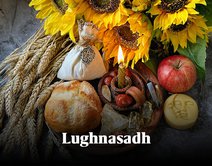As the earth moves through the cycles of the seasons, a marvelous harvest celebration that has been celebrated for centuries is held on August first, and it is called Lughnasadh. While it’s not become a worldwide celebration like the Winter Solstice has, it was a very important high day for ancient Britons, and a day when they paid tribute to a goddess who gave her life for the people.
Trips to holy places, trial marriages, and a gorgeous festival, all in celebration of the life of a goddess with a spacious heart. This is traditional Lughnasadh celebrations. While it’s not as famous as Samhain that was reborn as Halloween, it is counted as one of the most sacred days of the year, as well as a harvest celebration.
What is Lughnasadh?

Lughnasadh is a seasonal harvest festival that is one of four ancient high days celebrated in parts of the ancient British Isles. It joins Samhain on November 1st, Imbolc on February 1st, and Beltane on May 1st as one of the most sacred and festive days of the year. Lughnasadh pays tribute to the goddess Tailtiu, the foster mother of the god Lugh. It takes place on August 1, between the Summer Solstice and the Autumnal Equinox. Some don’t celebrate the goddess, but they count it as the very beginning of the harvest season, with bilberries and first corn harvests being used in celebrations and feasts. Trial marriages as well as festivals, markets, feasts, and Olympic style games have been held throughout the centuries, and people still celebrate it today.
Lugh
The Irish god Lugh has been called Lug, Lugh Lamfadah, or Lugh of the Long Arm, and Samildanach, or “equally skilled in many arts”. It has been said he is worshiped in Wales as Lugus, with both Lugh and Lugus being considered as triple gods. Lugh is listed as one of the early kings of Ireland, and one who was a master of many skills who led his people on to great victory in battle, then he ruled for forty years. It is possible he was a real person who was later deified, and indeed he is credited with founding the Tailteann Games. Ensuring his people, the Tuatha De Danann, learned agriculture, liberating his people, and inventing the ball game fidchell, ball games, and horse racing. He was the son of Cian whose father was Dian Cecht, a physician of the Tuatha de Danann. Lugh’s mother was Ethniu, daughter of the Fomorian leader Balor. Ethniu and Cian’s marriage was to unite the Fomorians with the Tuatha De Danann, but the enmity between them endured.
Lugh was given to the queen of the Fir Bolg, one of the four groups of people in Ireland in those times, and that queen was Tailtiu who fostered him. Upon reaching adulthood, Lugh went to Tara in Ireland to the Tuatha De Danann, his father’s people, and asked to be welcomed, but he was told that in order to enter, he had to bring a valuable skill. He said he excelled in crafts, sorcery, being a historian, poetry, smithing, fighting with swords, writing, playing the harp, and being a champion. He was told they already had someone for each of these skills, but he was admitted when he pointed out they did not have somebody who excelled in all those things.
They were not disappointed in Lugh, who soon defeated Ogma, their champion at flagstone throwing, and he impressed them with his skills as a harpist. Soon, he was promoted to war commander and began readying the Tuatha De Danann to battle the Fomorians, his mother’s people who were oppressing them. He first avenged his father’s death and forced the killers to bring him things such as a magical spear that makes the wielder impossible to defeat, as well as seven miraculous pigs who could be killed and eaten, but be alive to be eaten again the next day. Plus, a pig skin that healed all illnesses and injuries. They died from their travels to retrieve these miraculous items, and afterwards, Lugh liberated his people from the Fomorians. After his foster mother died, he established the Tailteann Games in her honor and overcame spirits of the Otherworld who tried to keep the people’s farm harvests for themselves instead of allowing the people to eat. He ruled for forty years before he was killed by the sons of a man who he had killed for having an affair with one of his wives.
Tailtiu
The foster mother of Lugh, Tailtiu was the queen of the Fir Bolg. Her name comes from Welsh and means “well formed” and “beautiful.” She was the wife of king Eochaid mac Eirc, who was the first king of Ireland to ensure justice prevailed in Ireland. However, somehow, no rain fell during his reign, only dew. He reigned a short ten years and died of thirst in a battle with the Tuatha De Danann because Druids used their magic to hide all water sources from him. Tailtiu was a loving woman whose heart energy was for her people. Her road to happiness entailed clearing the fields of Ireland to allow for planting, and her devotion to her people was one of the good qualities to have which meant she was venerated when she died from exhaustion from the work she did. She is memorialized every year in a Lughnasadh festival.
How it Was Celebrated

The celebration began back before written history and survives in many forms to this day as it has been celebrated in different ways by different people. It has been celebrated since before the eleventh century, when it was written about in The Book of Invasions, and an elaborate festival of contests for athletics and the arts was held. Festivals celebrating the first fruits of the harvest were held, and trial marriages were as well. The event could go on for a total of two weeks with the final day being to honor Tailtiu’s memory.
The Tailteann Games
The legendary event established by Lugh, this was held in what is now called Teltown, in County Meath, Ireland. This was a specific type of gathering, called an Aonach, which was a funerary gathering held in honor of royalty, heroic warriors, or wise people who were held in high esteem by the people. Cremation or burial of the dead took place at the gathering and there were truces among all attendees. The dead were honored and memorialized in song by Druid Priests, and laws and contracts were drawn up. At the end of all this were celebratory competitions for athletics and the arts. The Tailteann Games were one of many different ones in the history of Ireland held, but this one has moved forward into modern times into a high day religiously as well as culturally.
It is said that at the first Tailteann Games, Lugh honored Tailtiu and buried her in a mound at Teltown. Different sources have different theories as to when the Tailteann Games started with some placing it as early as 1600 BCE and others as late as 829 BCE. There are lists of the High Kings of Ireland and different scholars assign different dates to each king. Geoffrey Keating places Lugh as being king from 1447 to 1407 BCE and The Annals of the Four Masters date his kingship to 1870 to 1830 BCE. If it was Lugh who established the memorial games to Tailtiu, its beginning would have been anywhere from the earliest to the latest of these dates, meaning it has been celebrated for as long as over three thousand years.
There is no way to know exactly what the people would have done so long ago, but a look at today’s people shows a variety of different ways of celebrating including reviving the Games although in large scale they officially ended after the Norman Invasion. The Irish revived the Tailteann Games in the years of 1924, 1928, and 1932 having been inspired by the Olympics, and including chess competitions as well as golf, handball, motorcycling, rowing, and other newer events that were not included in ancient Games. Unfortunately, they could not raise enough funding to continue this further, and 1932 was the last year they were able to do this. Other things like travel to holy places became a part of the festivities and feasting on the first fruits of the season of bilberries which are similar to blueberries and corn were ritually offered to the gods.
It is probable that before Lugh established the Tailteann Games for Lughnasadh, the day was a celebration of the beginning of the harvest. Some writers say a month-long celebration could be held and people in Wales and England had harvest celebrations. August was just the beginning harvest, with little being ready that early, but the holiday kicked off the harvest season in general, with around November 1, Samhain being the final harvest. Thanks to the gods was given, and prayers for continued success for the growing season would be made.
In ancient times, laws would be drawn up, and contracts redone. The dead would be honored, and there would be celebrations of life and culture. Another part of the Games was trial marriages, for those seeking energy for finding love.
Laws
Nobles and kings would draw up laws at these gatherings, renewing old contracts, or replacing them with others. Some workers would be contracted for another year until the next Lughnasadh, and some would be let go from jobs, but would find a new employer at the gathering. Rival business people would come together and forge business alliances, and the Lughnasadh gatherings were an important time for trade, as it was one of the few times when truces were made and people who regularly fought one another would stop fighting long enough to come together in the name of partnerships that would benefit everybody. Leaders from neighboring communities would come together to make agreements, and the spirit of level headed cooperation to benefit everybody’s community was the rule of the gathering.
Honoring the Dead
The respect paid to Tailtiu by the people, even years after she lived cannot be stressed enough. She is credited with being the one responsible for the fact the people could farm, and therefore eat. Some writers say she was not a real person, but represented the earth itself, and was a mother earth goddess the people memorialized at the beginning of harvest. Thanks was given to her for the sacrifice of her body, which the fruits and vegetables grew in, to feed the people. Then again, she very well may have been a real person who truly died of exhaustion while working to clear land for farming. Either way, up to three thousand years after her event was first established, some still memorialize her every year at Lughnasadh.
Celebrations and Games
Wikipedia lists the ancient Tailteann Games as hosting competitions in: “Games included the long jump, high jump, running, hurling, spear throwing, boxing, contests in swordfighting, archery, wrestling, swimming, and chariot and horse racing. They also included competitions in strategy, singing, dancing, and story-telling, along with crafts competitions for goldsmiths, jewelers, weavers, and armourers.” GTo read that article, see here: Tailteann Games (ancient) - Wikipedia
Festivals for Lughnasadh were not just for the competitive games. Artists, craftspersons selling their goods, bakers and cooks sharing their foods, as well as people who made and sold musical instruments could set up to sell things. Think of modern-day festivals and all the kinds of people who vend their jewelry, clothing, decorations for the home, things for animals, things for the garden, reading materials, and even magic and ritual supply. All the things that people would want to buy could be at the festival at Tailteann Games.
Today, other places host festivals with one being a festival called Puck Fair that takes place in County Kerry, Ireland. A large event in North America which coincides with the dates of Lughnasadh is the Dublin Irish Festival held in Dublin, Ohio. Over four hundred thousand people attend the festival enjoying food, music, cultural education, storytelling, a marketplace and even a Highland Bagpipes showcase. At The Dublin Irish Festival, a Druid Liturgy commemorating Tailtiu is held. These are not exact replicas of the ancient Tailteann Games, but they continue the traditions established there. For more information, see here:2022 DUBLIN IRISH FESTIVAL - Dublin Irish Festival
Trial Marriages
If you were a single person attending a Tailteann gathering, and you were seeking love compatibility, you could participate in a trial marriage that would be good until the following Lughnasadh. Attracting love and choosing your own partner did not necessarily happen, however, and compatibility was not always considered in pairing couples together. They would be “joined” by holding hands through a hole in a door, and some couples had never even seen one another before this. The facts about love and relationships were taken into account, however, with no one wanting to deal with marrying a woman you don’t love. It was decided that if a man loves a woman, after the year, the couple could make their union permanent, and if not, they could say love comes in many forms, and part as friends at the following Lughnasadh.
Reek Sunday and Lammas
Some of today’s Christians observe Reek Sunday during Lughnasadh. The celebration is at least fifteen hundred years old and may be even older, possibly predating Christianization of Ireland. A pilgrimage up Croag Patrick, the holiest mountain in Ireland is done by tens of thousands of people, and a Catholic Mass is held at the top. Some people walk prayerful rings around the mountain, and others do the pilgrimage barefoot to serve penance. It takes about two hours to ascend, and about ninety minutes to descend the mountain. Medical rescue teams are on hand because each year, there are injuries, and even cardiac arrest sometimes, so people need their help. The pilgrimage is for prayer, and inspiration from their god.
Lammas, observed by Pagans, on the other hand, celebrates the beginning of the harvest season with the Fall Equinox, and Samhain being the other two harvest Sabbats, or holy days they celebrate. Like the ancient pre-Christian Pagans, today's neo, or new Pagans venerate the role the mother goddess and earth play in nourishment of humanity and they give thanks. A corn dolly or bread dolly is sometimes “sacrificed” ritually to the earth, and the people partake of the feast as well. The word Lammas is also used by some Christians, who in agricultural communities still do a blessing of first corn and breads in their churches.
Symbols of Lughnasadh

Lughnasadh, Lammas, or Tailteann Games have a lot of symbols people recognize as sacred. The corn dollies and loaves are a symbol of the high day as well as our personal accomplishments. Divine mothers in general are also venerated.
Corn Dollies and Loaves
There is a belief that the corn holds a spirit that must be preserved. So, when the last of the corn is harvested, the husk from that is formed into a corn dolly and is kept safe until the next year when it is buried, or “planted” in the ground so the spirit can return to the earth, and make the corn grow again. Loaves or cakes baked from the first harvest of the year are blessed and either buried to be gifted to the earth, or eaten by the people to bless them. Prayers are also said over these breads as they are baking, asking for blessings and prosperity for the people for the coming year.
Our Accomplishments
Not everybody these days participates in growing food, so the things we harvest are the accomplishments we have made. Maybe we completed a school program that we are proud of, or we got through a particularly grueling quarter at work with our sanity intact. Each of us will have done something wonderful that we give as an offering to our higher selves at the season of Lughnasadh and we can give thanks to our gods and guides for helping us to make it that far. We can also ask for blessing of the tools we use for our work and self-growth, as we continue setting goals and meeting them.
Divine Mothers
Mother goddesses of creation, whose bodies represent the green, growing earth are also symbols of Lughnasadh. Another goddess of life is Nerthus, Norse earth goddess. It is believed her high day happened in Spring, but maybe not. Perhaps she helped with harvests and was venerated later in the year. Tacitus, a Roman writer had this to say about her:
“…The Langobardi are distinguished by being few in number. Surrounded by many mighty peoples they have protected themselves not by submissiveness but by battle and boldness. Next to them come the Ruedigni, Aviones, Anglii, Varini, Eudoses, Suarines, and Huitones, protected by river and forests. There is nothing especially noteworthy about these states individually, but they are distinguished by a common worship of Nerthus, that is, Mother Earth, and believes that she intervenes in human affairs and rides through their peoples. There is a sacred grove on an island in the Ocean, in which there is a consecrated chariot, draped with cloth, where the priest alone may touch. He perceives the presence of the goddess in the innermost shrine and with great reverence escorts her in her chariot, which is drawn by female cattle. There are days of rejoicing then and the countryside celebrates the festival, wherever she designs to visit and to accept hospitality. No one goes to war, no one takes up arms, all objects of iron are locked away, then and only then do they experience peace and quiet, only then do they prize them, until the goddess has had her fill of human society and the priest brings her back to her temple. Afterwards the chariot, the cloth, and, if one may believe it, the deity herself are washed in a hidden lake. The slaves who perform this office are immediately swallowed up in the same lake. Hence arises dread of the mysterious, and piety, which keeps them ignorant of what only those about to perish may see.”
What may seem a grisly tradition was one founded on honor and respect of the goddess. Nobody save her Priests were permitted to see her radiant face, which was veiled when she was taken to bless the people, but the men who pulled her out of the water saw her before she could be veiled. They may have asked for the honor of seeing her and carrying her, and willingly offered their lives to her. Like Tailtiu, who sacrificed for her people, the men who delivered Nerthus sacrificed theirs. Today, nobody knows where this statue lies. Time may reveal.
Any mother goddess and earth goddess can be venerated at any time of the year, but at the beginning of the harvest season, some people see it as an especially important time to thank these goddesses for nourishing humanity with their hearts, souls, and their very body which represents the earth itself. To see more about what tacitus said about Nerthus, see here: Nerthus - Wikipedia
How to Celebrate Lughnasadh

Not everybody belongs to a Christian or Neo Pagan group celebrating Lughnasadh in the traditional ways, but even if you don’t, the energy of the season can bless you. You can find new love or reunite with loved ones, and even if you don’t do these things, offerings can be made.
Finding New Love
As Lughnasadh historically had people seeking their person tied to love, fate, destiny, and lifelong commitment, you too can take the energies from the holiday to find love. For the love of a woman or man to come to you, a simple meditation for attracting love will help. Simply sit quietly, and let your heart speak to you of what it is you are looking for in a lover. Keep pencil and paper nearby so you can write everything down. Some people seek fun lovers and others seek committed lovers. Whatever it is you are wanting in a lover, writing it down and reading it to yourself will help you to become consciously aware of these things. If a man loves a woman, he will show it, and Lughnasadh may be just the time when you can open yourself to love you paying extra attention to what kind of love you are seeking.
Family Reunions
As Lughnasadh was traditionally a time when people would come together, you can use that time to do a gathering of your own. Invite all family and friends you want to gather together and enjoy each other’s company. Some families say it is a shame they don’t get together often enough, but you can do something about that and facilitate a gathering so everybody can come together. If you are able to, host your gathering somewhere beautiful where everyone can enjoy the August weather. Make sure to include good food in your celebration so that nourishing the bodies of the people you love is given equal importance to nourishing their emotional selves.
Offerings
Gifts to the earth and to deities has always been a part of Lughnasadh, and today’s Lughnasadh celebrations don’t have to be without that. Whatever you offer to the earth will be noticed and appreciated. Perhaps you want to plant a tree to help the environment or give up a habit that is bad for the ecosystem, and you buy a reusable water bottle instead of buying disposable water that creates trash. You can offer your time for a cause that supports mothers in honor of the mother goddess, and you can even buy foodstuffs to feed wildlife. Maybe you don’t have money to spend but will go for a walk instead of a ride more often to reduce pollution. The earth will notice and appreciate whatever your offering is.
No matter how you celebrate the first harvest, may the energy of the season bless you and show you all the things you have accomplished in your life. May the powers that be give you great blessings and may the things you harvest be meaningful and help with your spiritual growth. So Be It.
We have selected the most relevant psychics for this article, you can connect with any of them and get accurate advice on this subject.









